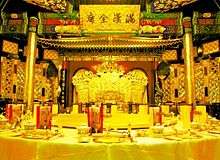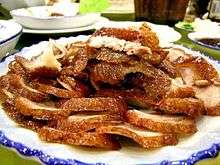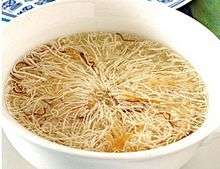Chinese Imperial cuisine
 |
| This article is part of the series |
| Chinese cuisine |
|---|
|
Regional cuisines
|
|
Ingredients and types of food |
|
|
Chinese imperial cuisine (simplified Chinese: 御膳 / 宫廷菜; traditional Chinese: 御膳 / 宮廷菜; pinyin: yùshàn / gōngtíng cài) is derived from a variety of cooking styles of the regions in China, mainly from Shandong cuisine and Jiangsu cuisine. The style originated from various Emperors' Kitchen and the Empress Dowagers' Kitchen, and it is similar to Beijing cuisine which it heavily influenced. Imperial cuisine was served mainly to the emperors, their empresses and concubines, and the imperial family. The characteristics of the Chinese imperial cuisine are the elaborate cooking methods and the strict selection of raw materials, which are often extremely expensive, rare, or complicated in preparation. Visual presentation is also very important, so the color and the shape of the dish must be carefully arranged. The most famous Chinese imperial cuisine restaurants are both located in Beijing: Fang Shan (仿膳; fǎngshàn) in Beihai Park and Ting Li Ting (听鹂厅; 聽鸝廳; tīng lí tīng) in the Summer Palace.[1]
Styles and tastes of Chinese imperial cuisine vary from dynasty to dynasty. Every dynasty has its own distinguishing features. The two famous styles of Chinese imperial cuisine are from the Ming and Qing dynasties. Many famous dishes emerged in these dynasties, such as Wensi Tofu and Peking Duck.[2]
History
In the history of Chinese cuisine, Chinese imperial cuisine experienced a development progress which changed from simple to exquisite. Through the changing of dynasties, Chinese imperial cuisine was continually changing, improving, and self-completing. Chinese imperial food originated around the Zhou dynasty (11th century BC – 476 BC). Emperors used their power to collect best cuisines and best cooks from the whole country. Therefore, from the Chinese people's perspective, imperial cuisine represented a dynasty's best cuisine.[2]
A complete system for imperial cuisine was developed which included procurement and diets preparation. Every progress of making and serving imperial cuisine was done in a fixed order according to the "eating principles." Many famous dishes were developed through creating imperial food such as the six cereals stew which included rice, millet, broomcorn, sorghum, wheat, and wild rice.[3]
Imperial cuisine was closely related to preserving health. Several hundred writings about using food and diet therapy for better health have appeared throughout Chinese history. For example, The Health Building of the People in the Song Dynasty, by Song Xu, the Gentlemen's Remark on Diets, by Chen Jiru, and the History of the Ming Palace - Preferences for Diets, by Liu Ruoyu in the Ming dynasty. Most of these books about diet therapy were written by scholars, literati, medical specialists, or historians. Cooking and diet therapy to maintain good health formed an important part of Chinese imperial cuisine and Chinese dietetic culture.[4]
Although only the imperial family was authorised to consume imperial cuisine, Chinese imperial cuisine comprised the dietetic culture of the Chinese palaces. The raw materials of imperial cuisines were provided by peasants, herders, and fisherman. The kitchen utensils were made by craftsmen. Imperial cuisine can also represent the efforts of the cooking staff who provided the service, civil officials who named the dishes, and protocol officials who drafted the dietary and culinary principles. Chinese imperial cuisine is an valuable part of Chinese traditional cuisine and cultural heritage.[5]
Imperial cuisine in the Ming dynasty
Imperial cuisine in the Ming dynasty was mostly cooked with the flavors of southern China because of the preference of the founding emperor of the Ming dynasty, Zhu Yuanzhang.[6] The cuisine in the Ming palace totally changed the Mongolian style of food served during the Mongol-led Yuan dynasty. The imperial cuisine of the Ming dynasty had one important characteristic, which was to protect health.[7] The emperors of the Ming dynasty paid great attention to protecting health by eating healthy food. The menu of imperial cuisine changed daily and dishes were not repeated.[8] Imperial cuisine of the Ming dynasty was mainly grain-based. Therefore, meat and bean products were not as popular as they were in the former dynasties. In the Qing dynasty, a famous dish was sweet potatoes. Maize and chili peppers were also introduced in about mid-16th century. Other famous dishes included shark's fin soup and edible bird's nest also gained their fames during this period. Those two dishes were introduced to China by the explorer Zheng He in the early Ming dynasty. While these two dishes were becoming examples of extravagant dishes, sea cucumbers and prawns were also brought into China. Many famous cooks and chefs such as Song Wusao and Wang Eryu emerged in the Ming dynasty.[3]
Popular dishes
Peking Duck

Peking Duck originated in the Southern and Northern Dynasties (420-589 AD). Roasted duck was first served as a dish in imperial cuisine during the Yuan dynasty. It developed fully and became an important part of imperial cuisine menus during the Ming dynasty. In contemporary society, Peking roasted duck has entered international cuisine. Its unique taste was favored by both Chinese and non-Chinese. Peking roasted duck was famous because of its crispy skin and the juicy meat which left a deep impression on people eating it for the first time. There are unique techniques to serving and eating Peking Duck for maximum enjoyment of its taste.[9]
Imperial cuisine in the Qing dynasty

Chinese imperial cuisine in the Qing dynasty was developed basing on the traditional diet of the Manchu ethic group and Shandong cuisine.[10] The famous Manchu Han Imperial Feast was created during this dynasty. There was a special organization, the "Imperial Kitchen", within the Qing imperial palace which was responsible for creating and making imperial cuisine for the emperor. The Imperial Kitchen was managed by the General Office of internal Affairs. During the reign of the Qianlong Emperor (r. 1735–1796), the Imperial Kitchen was divided into the Internal Kitchen and the External Kitchen. The Internal Kitchen had departments for meat dishes, vegetables, roasting, baking, and rice cooking. The External Kitchen prepared the palace banquets, feasts, and sacrificial rites.[2] During the Qing dynasty, the rites for the meals, the number of people, and the use, cost, variety, and quality of sumptuous courses at each meal were the greatest of all the dynasties in China.[2]
Popular dishes
Dezhou Braised Chicken

Dezhou Braised Chicken is a traditional cuisine of Dezhou in Shangdong Province and it is named after its place of origin. When the Qianlong Emperor traveled to Dezhou, a Han Chinese family made Dezhou Braised Chicken for him. The emperor thought highly of this dish and praised it as "a wonder of all cuisine." After eating Dezhou Braised Chicken, the Qianlong Emperor ordered that this dish be included in the menu of imperial cuisine.[11]
Wensi Tofu

Wensi Tofu is a dish in Jiangsu cuisine. It is a soup made of finely shredded tofu and different ingredients of different colors, such as carrots and cucumbers. This dish represents the typical work of knife skill of a Yangzhou cook because a cook needs to cut a square of tofu into more than 5,000 pieces in order to make this soup.[12]
During the reign of the Qianlong Emperor, there was a monk by the name of Wensi, who was famous for making vegetarian dishes, particularly those with tofu. He created this soup which ingredients included tender tofu, dried daylily, and black fungus. This soup soon became well-known throughout the whole region as "Wensi Tofu".[13] The Qianlong Emperor tried this soup and highly appreciated it. Wensi Tofu then added by the emperor to the menu of imperial cuisine.[14]
See also
- Shandong cuisine
- Jiangsu cuisine
- Beijing cuisine
- Shandong cuisine
- Peking Duck
- Dezhou braised chicken
- Shark's fin soup
- Edible bird's nest
References
- ↑ "The History of Chinese Imperial Food". Beijing Tourism. Beijing.com.cn.
- 1 2 3 4 "The History of Chinese Imperial Food". China.org.cn. China.org.cn.
- 1 2 "Premodern Chinese Food. Chinese Culinary History before the Republic of China". WHKMLA.
- ↑ Xu, Song. The Health Building of the People in the Song Dynasty.
- ↑ "The History of Chinese Imperial Food". China Culture. Kaleidoscope.cultural-China.com.
- ↑ "Chinese Imperial Food-Imperial Food in the Ming Dynasty". Acutimes.
- ↑ Tingquan, Zhang (1998). Chinese Imperial Cuisines and Eating Secrets (Chinese/English ed.). Panda Books. ISBN 978-7507103762. Retrieved 28 Oct 2014.
- ↑ "Imperial Food in the Ming Dynasty". China.org.cn.
- ↑ "WANDA REALM BEIJING". Travel China Inc.
- ↑ Jacqueline M. Newman. Qian-Long: Qing Emperor and His Foods. FAVOR & FORTUNE. 2008;15(1): 14–33.
- ↑ "Dezhou Braised Chicken". China Today.
- ↑ "Famous Yangzhou dishes". english.cntv.cn.
- ↑ "JiangNing Clubhouse". Jiang Ni Hui Guan.
- ↑ "Wensi Tofu". China Today.
External links
- The History of Chinese Imperial Food. China.org.cn.
